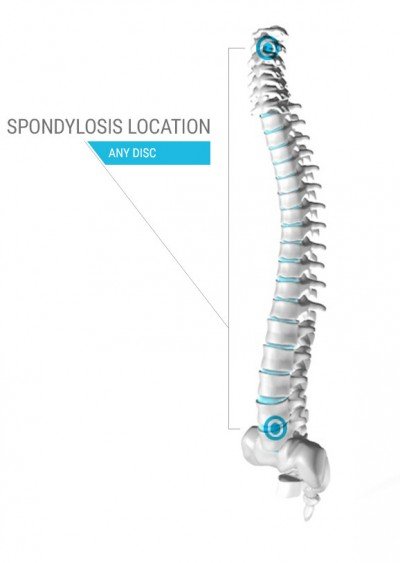
Spondylosis Treatment in Clearwater
Spondylosis is a broad medical term used to describe back pain generally caused by wear and tear during the body’s aging process. People suffering from Spondylosis have symptoms ranging from spinal neck pain to joint pain to bone pain.
Most often, Spondylosis is caused by spinal osteoarthritis or degenerative disc disease, but it can be used to describe any manner of spinal degeneration.

What Are the Symptoms of Spondylosis?
The physical symptoms of Spondylosis include the following:
- Back Pain
- Neck Pain
- Joint Pain
- Weakness
- Osteoarthritis
- Lumbar Spine Pain
- Tingling
- Numbness
- Loss/Restriction of Motion
What Causes Spondylosis?
Spondylosis is most often caused by the natural aging process. Although spondylosis a broad term used for back pain caused by wear and tear, specialists most commonly use it to describe osteoarthritis. Spondylosis is caused when discs, muscles, or cartilage deteriorate naturally over time.
This can result in:
- Pain
- Stiffness
- Weakness
- And other symptoms
While natural degeneration is the most likely cause for Spondylosis, people who are overweight, genetically predisposed or have had a history of spine injuries, may be at a higher risk.
How is Spondylosis Diagnosed?
Your doctor will schedule a physical exam and history report as the first step to determining if you suffer from Spondylosis. X-rays, MRIs and CT scans are generally scheduled as a follow up to pinpoint specific causes of your pain from Spondylosis.
How is Spondylosis Treated?
Most patients with Spondylosis can be treated non-surgically through conservative care. The patients must be educated to understand the goal of therapy and have realistic expectations.
Treatment begins with the simplest mode of therapy, such as temporary limitations of physical activities and non steroidal anti-inflammatory drugs (nsaids). If no improvement occurs over a 3-6 week period, a change in the type of Nsaid or a trial of epidural steroid injections may be considered. Bracing may also be an option.
Physical therapy has variable affects. Patients who do not respond to conservative treatments, or whose Spondylosis is debilitating may be candidates for surgery. Talk to your surgeon about what option is right for you.
The Latest In Orthopedics
-
 Tips to Help Manage Pain From a Spinal Injury
Tips to Help Manage Pain From a Spinal InjuryUnderstanding Spinal Injury Pain Management Recognizing Different Types of Spinal Injuries Spinal injuries can be as ...
Read More -
 5 Symptoms of Back Issues That Are Commonly Overlooked
5 Symptoms of Back Issues That Are Commonly OverlookedBack pain is one of the most common physical complaints across all ages and populations. In most cases, it is caused by ...
Read More -
 Prepping Your Body for Pickleball
Prepping Your Body for PickleballPickleball is a sport that has gained immense popularity in recent years, and for good reason. It is fun, exciting, and ...
Read More -
 Posture Correction for a Healthy Spine and Reduced Back Pain
Posture Correction for a Healthy Spine and Reduced Back PainIt's no secret that good posture plays a significant role in maintaining a healthy spine and reducing back pain. ...
Read More
.1).2402231023323.jpg)
.2402131331577.jpg)

